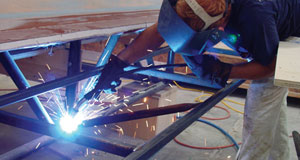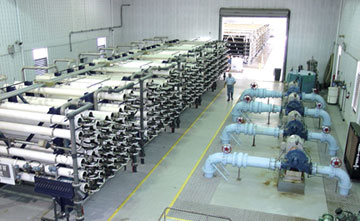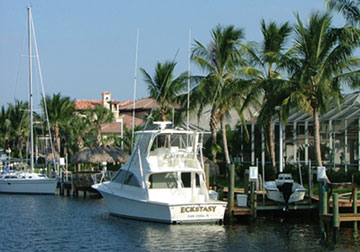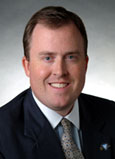An Editorial Profile: Cape Coral, Florida
Next Hurdle: Securing Land
|
The Insider
Mayor Outlines Ambitious Agenda
To get an insider's perspective on the future of the Cape, Site Selection interviewed Cape Coral Mayor Eric Feichthaler. An attorney with considerable experience in real estate transactions, he moved to the Cape from Philadelphia in 1987. An economics graduate of the University of Miami, Feichthaler also holds law degrees from Georgetown University and the New York University School of Law. SITE SELECTION: What is your vision for the city of Cape Coral? MAYOR FEICHTHALER: My vision is to have a Cape Coral where people can live here, work here, find entertainment here and basically do everything on the Cape. We have several light industrial businesses that are thriving here. This is a very good place to do business. I see a lot more commercial development, including restaurants and entertainment, coming to the Cape. Plus, one of my goals is to bring a minor league baseball team and a Major League Baseball spring training team to Cape Coral. SS: What types of employers would you like to attract to the Cape? MAYOR: I'd like to see a broad-based economy. What is lacking is an office environment and corporate campus office park. We need to encourage those large and small corporate headquarters to move to Cape Coral. Also, I see light industrial such as aerospace increasing here. And we will see a much larger expansion of direct retail. SS: How long will it take for the Cape to become a thriving employment center? MAYOR: It will be more difficult than I had hoped because land values are increasing at a very rapid rate. Because of the annexations we are doing in the North Cape, in the next two years more of the country will discover this area and the incentives we are offering. Within five years, a nationally known company will have either its corporate headquarters or regional headquarters here. SS: What must change for the Cape to become more competitive for industry? MAYOR: Because we are a pre-platted community, this city was designed more than 40 years ago to be a bedroom community for people who worked someplace else. But the entire population will be very happy to see those businesses come into the city. We have streamlined the permitting and inspection process. We will be in front of the curve and get very good feedback quickly on what needs to be done on site development. We have also worked very hard with our codes not to over-require anything. But we do have regulations for landscaping and blending into the surrounding residential environment. Cape Coral, as far as Florida is concerned, is one of the best places to do business. I plan on living the rest of my life in Cape Coral, and I'm only 33. |
About 8 percent of the Cape's 115 square miles (298 sq. km.) are set aside for commercial and industrial development, but Jackson wants to double that amount.
Two state-approved developments of regional impact are crucial parts of Jackson's plan: the 218-acre (88-hectare) Hancock Creek Commerce Park and the 254-acre (103-hectare) Indian Oaks Commerce Park. But he knows it will take more than that if Cape Coral is to one day fulfill his dream of providing a job within five minutes of every Cape resident. Jackson estimates that the city needs 1,800 acres (729 hectares) set aside for future office and industrial space.
The problem for Jackson and his pro-business City Manager Terry Stewart is that two men named Jack and Leonard Rosen beat them to the punch nearly half a century ago. The first ads for small residential lots on the Cape began appearing in Northern newspapers and magazines in January 1958.
Interest soon mushroomed to the point that the Rosens were flying six airplanes five flights an hour six days a week over a peninsula called Redfish Point to show post-World War II families the site of their future American dream. Within a few short years, more than 138,000 separate homesites were sold to people from every U.S. state and many foreign countries that no longer appear on the map. About 21 percent of the Cape's population claim German descent.
Connie Mack Jr., son of the legendary baseball manager Connie Mack of the then Philadelphia Athletics, was known as the "marketing guru" of the Gulf American Corp., selling undeveloped lots by the hour to people who dreamed of coming to this winter wonderland of wealth, water and warm Gulf breezes.
| Light industrial companies are supported with job training and skills enhancement programs in Cape Coral and surrounding Lee County. This worker is completing a sub-assembly for fabrication of a fiberglass yacht mold. |
 |
 |
| Cape Coral invests heavily in ensuring a plentiful supply of potable water. The Cape's reverse osmosis plant — one of the first in the nation — purifies water from deep wells, which means the city is not dependent on surface aquifers. The Cape will more than double its potable water production with construction of a second such facility in the next five years. |
The GAC was, in many ways, the Walt Disney Co. of Florida before anyone had even heard of Disney World. Only they weren't selling theme park tickets; they were selling a way of life.
Their unparalleled success is the main reason why Cape Coral's current city manager faces such a monumental task: retooling a 1950s-era boomtown to suit the economic realities of 2006.
"We really face two immediate issues: pent-up demand for commercial and industrial properties; and a work force that is ready to stay here," says Stewart, who left a less hectic job in city administration in Pembroke Pines, Fla., in Broward County, for the more challenging boomburb of Cape Coral.
"This city is analogous to an awakening giant. There is a pending explosion of commercial and industrial growth, and my goal is to provide an atmosphere and a place where we can attract the light-to-medium industry that is ideally suited to the Cape lifestyle," says Stewart. "I don't believe you can take any other model of economic development and recreate it here, because we are a pre-platted community."
That means cobbling together enough building sites through acquisition and working with private developers to secure a supply of land to meet the demands of commercial and industrial growth.
|
For more information call (239) 574-0444, email mjackson bounce@capecoral.net or visit www.bizcapecoral.com. For information on Site Selection editorial profiles, contact Mark Arend, Editor, at mark.arend bounce@conway.com or (770) 325-3438.
|
Stewart believes it can be done. "It takes a lot of work, a lot of hard work, but we are destined to push this community toward greater economic development. The pent-up demand will force it," he notes. "That means we must assist industry in identifying appropriate business locations for their facilities."
Toward that end, the city is pursuing a two-pronged strategy of providing an aggressive incentives package to help developers piece together industrial parcels and carving out what Stewart calls "commercial activity centers" — nodes of commercial and industrial development clustered with residential housing, retail, restaurants, city services and recreational amenities.
In addition, in the downtown Community Redevelopment Area, 440 acres (178 hectares) are now the site of four major commercial and industrial projects totaling $890 million in combined capital investment.
Together with other projects already in the pipeline and the city's planned $500 million investment into new water and sewer plants (including a second reverse osmosis plant that converts saltwater into drinking water) in the next five years, experts estimate that the Cape will be the site of more than $2 billion in new commercial, industrial and municipal construction between 2005 and 2010.
That doesn't even include the new big-box retailers like Lowe's, Home Depot, BJ's Wholesale and others that are flocking to the Cape in droves to cash in on an affluent customer base that averages $59,532 per household in annual income.
 |
"We are the best-kept secret in the country, but that's about to change," Stewart says. "We want Corporate America to understand who we are. We're not going to tell them we're something we're not. We take a very pragmatic approach. For the right company, this is the right place to be."
Ezerins, who built his Alvion Technologies from scratch in Cape Coral, agrees. "If you are looking for a high-quality, service-oriented work force of 50 to 100 people or more, I would strongly look at this area," he says.
"Right now, I'm looking at either building or purchasing a new facility, and I'm going to stay right here on the Cape."



